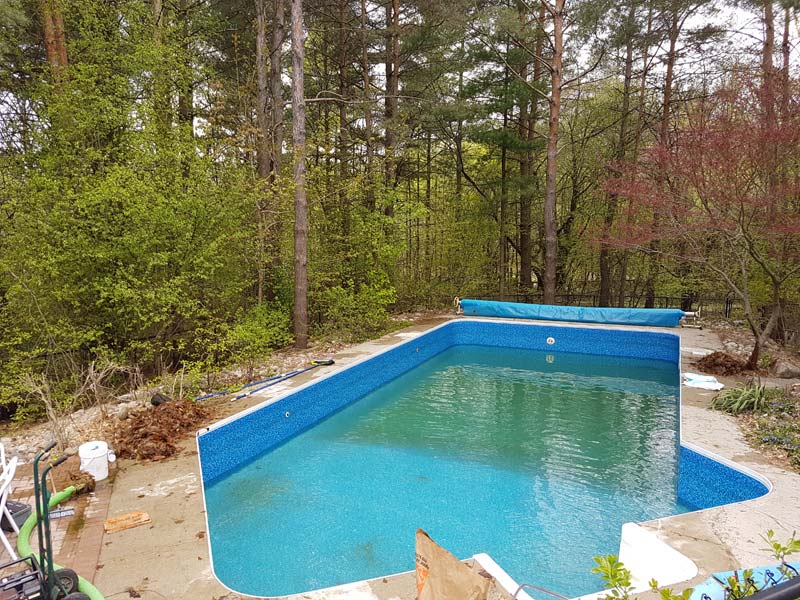Beneficial ammonia

There are products that incorporate compounds of ammonia used to remove algae and clean-up water. Two products for algae are quaternary ammonium and poly-quaternary ammonia used to fight against green algae. Both of these products incorporate an ammoniated compound that serves to lower the water surface tension. This causes the algae to take in a toxin, which splits the cell wall.
When used in well-maintained pools, along with recommended levels of free chlorine, ammonia will combine to form inorganic chloramines. The first reaction of ammonia in a chlorinated pool is with hydrogen ions. This quickly forms ammonium ion. The ammonium ion reacts with hypochlorous acid to form monochloramines, which then reacts with free chlorine to from dichloramines. Dichloramine is unstable and rapidly decomposes. Its nitrogen content oxidizes to elemental nitrogen gas and is released into the atmosphere. Quaternary algaecides cause foaming. Poly-quaternary algaecides have a cationic (positive charged) polymer added. The poly-quats do not foam, but they will also act as a flocculant and diminish the effectiveness.
There are ammonia enhancer products that incorporate the use of ammonium sulfate salt. The salt releases ammonium and sulfate ions in water. Chlorine shock oxidizes the ammonium and free chlorine combines to create monochloramines, which are very effective against yellow algae, as well as clearing up green pools. After this treatment, the pool is super-chlorinated a second time to break up and remove the inorganic chloramines.
Some in the pool industry are of the opinion that the use of these ammonia-based products is problematic. The reason for this is the erroneous belief they will leave ammonia in the water. In fact, nothing could be further from the truth. Is ammonia left behind in the pool from the use of an ammonium salt? Would even adding straight ammonium hydroxide result in ammonia in the pool? The answer is no. This is because of the chemical reaction in pool water where ammonia quickly combines with chlorine to form inorganic chloramines. Ammonia ceases to exist once it reacts and combines with chlorine. The destruction of inorganic chloramines occurs in sufficient levels of free available chlorine (FAC).
Real contaminants
Atmospheric nitrogen from storms converts to nitrates in the pool via the nitrogen cycle. Waste from swimmers such as perspiration and urine that contains urea are the primary sources of detrimental nitrates.

The average adult secretes up to 30 ml (1 oz) of dilute urea daily in his/her urine. Urea in urine contributes 85 per cent of total nitrogen. Urea is a nutrient for bacteria and algae and is also a primary source of ammoniated chloramines. An extreme result of urea and chlorine will be the formation of toxic chloramines such as cyanogen chloride (CNCl) and trichloramine (NCl3).
These are both very toxic to breathe and, as a result, are especially problematic in indoor pools as they can cause lung and eye irritation to swimmers. Peeing in the pool is never a good thing; however, urea is also present in sweat and most active swimmers exude 470 ml (16 oz) of perspiration per hour. Pool operators may be able to stop people from peeing in the pool, but they cannot stop bathers from sweating. Other sources of nitrates can be from wild animals, such as bears and birds. Improper maintenance and lack of oxidation will lead to high chloramine levels.
When chlorine and ammonia meet
In pools, there are two categories of chloramines present in the water: inorganic chloramines (chlorine combined with nitrogenous ammonia) and organic chloramines (chlorine combined with organic nitrogen waste).
Inorganic chloramines
Inorganic chloramines are a quick reaction of chlorine with ammonia. As inorganic chloramines hold together longer than free chlorine, many drinking water facilities use chlorine and chemical ammonia to produce chloramines for disinfecting. These inorganic chloramines are more stable and maintain a residual longer than free chlorine. It will last from the water station through the pipes and to the faucet. This often results in a strong chloramine smell at the tap. This manufactured form of disinfecting drinking water is chloramination. Inorganic chloramines may be good for treating drinking water; however, in pools they are an irritant to swimmers and lead to eye, skin, and lung problems.
Consumption of free chlorine occurs in the process of oxidation of the chloramines. Most drinking water municipalities will show in their reports if they are practicing chloramination. Those living in areas where this method of water treatment is being used should test their water to determine the chloramine levels. Once the level is determined, increasing the free chlorine level can help to reduce the added chloramines.
Organic chloramines
Organic chloramines from chlorine combined with organic nitrogen are more difficult to break apart then those that are inorganic, as they do not respond to breakpoint chlorination. In fact, it can take many frequent super-chlorination shocks to begin to see any reduction. Another method could be frequent oxidizing with a non-chlorine shock known as potassium monopersulfate (MPS). The easiest and most efficient way to remove organic-bound chloramines is by draining the water and dilution.
One might wonder how they can tell whether they have inorganic or organic bound chloramines in their pool water since there is no test to determine the difference. There is a work around, however. After performing additional chlorination or raising free chlorine, re-test the total and free chlorine levels. Any combined numbers that remain after this are organic chloramines.
Draining, dilution, and additional shocking will remove the organic chloramines. Ozone units or ultraviolet (UV) disinfection systems are two proactive ways to prevent the build-up of combined chloramines in either the inorganic or the organic form by breaking them apart. Ozone is a stronger oxidizer than chlorine, while UV systems act to oxidize the precursors to chloramines. According to the Model Aquatic Health Code (MAHC), both act as secondary disinfectant systems.






